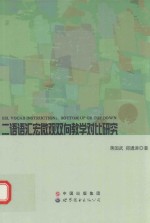

二语词汇宏微观双向教学对比研究PDF格式文档图书下载
Introduction 1
Chapter 1:Background 2
1.1 Introduction 2
1.2 Statement of the Problem 4
1.3 Research Objectives 4
1.4 Significance of the Study 5
1.5 Vocabulary Teaching in China 5
1.5.1 English as a Second Language in China 5
1.5.2 The Role of Vocabulary Knowledge 6
1.5.3 The Current Situation of Vocabulary Teaching in China 7
Chapter 2:Literature Review 8
2.1 Introduction 8
2.2 Approaches and Methods in Language Teaching 9
2.3 Approaches to Vocabulary Teaching 11
2.3.1 Incidental Approach 12
2.3.2 Intentional Approach 13
2.3.3 Word Association Approach and the Contextualised Approach 16
2.4 Vocabulary Knowledge and Development 17
2.4.1 Vocabulary Size 17
2.4.2 What is Involved in Knowing a Word? 19
2.4.3 Receptive Knowledge versus Productive Knowledge 21
2.4.4 The Development of Vocabulary Knowledge 23
2.4.5 Vocabulary Teaching and Learning Burden 29
2.5 Language Processing and the Conceptualisation of Bottom-up and Top-down 31
2.6 The Components of a Vocabulary Course 36
2.6.1 The Goals of Vocabulary Teaching 37
2.6.2 Needs Analysis of a Vocabulary Course 38
2.6.3 Environment Analysis 42
2.6.4 Teaching Principles 42
2.6.5 Teaching Content and Sequence 43
2.6.6 Format and Presentation 44
2.6.7 Monitoring and Assessment 46
2.6.8 Course Evaluation 47
2.7 Previous Research 48
2.7.1 Research on Bottom-up and Top-down Approaches 48
2.7.2 Research on Vocabulary Teaching 51
2.8 Chinese Culture and the Role of Culture in EFL Teaching 55
2.8.1 The Fundamental Features of Chinese Culture 56
2.8.2 The Role of Culture in EFL Teaching 57
2.9 Summary and Implications 59
Chapter 3:Methodology and Design 61
3.1 Introduction 61
3.2 Overview of the Research Project 61
3.3 Research Design 62
3.4 Participants 62
3.4.1 Research Sample 62
3.4.2 Recruitment 63
3.4.3 Allocation of Participants 64
3.5 Instruments 66
3.5.1 Background Information Questionnaire 67
3.5.2 Vocabulary Knowledge Tests 68
3.5.3 Course Evaluation Questionnaire 70
3.6 Research Procedure 71
3.7 Instruction 72
3.7.1 Teaching Procedure 73
3.7.2 Teaching Materials and Resources 75
3.7.3 Teaching Activities 77
3.8 Data Analysis 78
3.9 Summary 80
Chapter 4:Data Analysis 81
4.1 Overview 81
4.2 Preliminary(Descriptive)Analysis 81
4.3 Main Analysis 83
4.3.1 The Results of Academic Vocabulary Size Tests(AVST) 84
4.3.2 The Results of Controlled Productive Knowledge Tests(CPKT) 85
4.4 Conclusion 86
Chapter 5:Discussion 87
5.1 Overview 87
5.2 The Different Effect between Bottom-up and Top-down Approaches 88
5.2.1 Nature of L2 Lexical Acquisition and its Alignment with Bottom-up Processing 89
5.2.2 Learner's Low Proficiency Level Favours Bottom-up Processing 90
5.2.3 Socio-cultural and Traditional Factors in the Chinese Context 91
5.3 About the Vocabulary Course 102
5.3.1 Composition of the Course(in terms of Nation's four strands) 102
5.3.2 The Role of Explicit/Direct Vocabulary Instruction 104
5.3.3 Input Processing Management 105
5.3.4 The Instruction Targeted both Receptive and Productive Skills 107
5.3.5 Combination of both the Key Words Approach and the Contextualised Approach 109
5.3.6 Use of Online Resources 110
5.4 Conclusion 111
Chapter 6:Conclusion 112
6.1 Project Summary 112
6.2 Contribution of the Study 114
6.2.1 Contributions to Scholarship in the Field of L2 Research 114
6.2.2 Contributions to Second Language Pedagogy 114
6.3 Limitations of the Current Study and Recommendation for Future Research 115
6.4 Recommendations for Second Language Pedagogy 116
6.4.1 A Plausible,Heuristic and Eclectic Approach in ELT 117
6.4.2 Eclectic Dynamic Language Acquisition Model Integrating Bottom-up and Top-down Dimensions 120
6.5 Final Comments 124
References 126
Appendix A:Teaching Syllabus 137
Appendix B:Lesson Plan 140
Appendix C:Teaching Materials 148
1.Academic Words Lists(AWL)(Coxhead,2000) 148
2.Sub-lists of the AWL(Coxhead,2000) 153
3.IELTS Preparing Book(IELTS 7,2008,p.78) 154
4.The List of Target Teaching Words 156
5.Academic Vocabulary Exercises 160
Appendix D:Teaching Resources 166
1.Word Formation:http://wordinfo.info/ 166
2.Bilinguial online dictionary:http://www.iciba.com/ 166
3.WordNet Search 3.0:http://wordnetweb.princeton.edu/perl/webwn 167
4.Visualthesaurus:http://www.visualthesaurus.com/trialover/ 168
5.Oxford Collocation Dictionary Online:http://www.ozdic.con 168
6.Long Dictionary of Contemporary English:http://www.ldoceonline.com 169
Appendix E:Research Instruments 170
1.Background Information Collection Form 170
2.Vocabulary Pre and Post Tests 175
3.Course Evaluation Questionnaire 179
- 《二语词汇宏微观双向教学对比研究》蒋国武,郑通涛著 2016
- 《英汉语词汇对比研究》张维友著 2010
- 《汉英语气系统对比研究》王飞华著 2014
- 《中译翻译文库 实用英汉对比与翻译 英汉双向》彭萍编著 2015
- 《实用英汉对比与翻译 英汉双向》彭萍编著 2009
- 《琼北闽语词汇研究》符其武主编 2008
- 《《尔雅》普通语词研究》李冬英著 2010
- 《常用语词探源》周北辰编著 2007
- 《双向征服英语 我六月学成去哈佛 初级卷》席隆乾主编 2012
- 《双向征服英语 我六月学成去哈佛 高级卷》席隆乾主编 2012
- 《汉语国际传播热点透视 第5辑》郑通涛,方环海,陈荣岚编 2016
- 《汉语国际传播热点透视 第2辑》郑通涛,方环海,陈荣岚编 2016
- 《汉语国际传播热点透视 第1辑》郑通涛,方环海,陈荣岚编 2016
- 《汉语国际传播热点透视 第4辑》郑通涛,方环海,陈荣岚编 2016
- 《汉语国际传播热点透视 第3辑》郑通涛,方环海,陈荣岚编 2016
- 《二语词汇宏微观双向教学对比研究》蒋国武,郑通涛著 2016
- 《历史语言研究所集刊 第6本 第一分》国立中央研究院历史语言研究所集刊编辑委员会编 1936
- 《中国高铁创新体系研究》高柏,李国武,甄志宏著 2016
- 《摄影构图》徐国武,胡钢峰主编 2011
- 《摄影构成》王再,徐国武主编 2011
- 《IMI消费行为与生活形态年鉴 北京·上海·广州·重庆·武汉·西安 1998-1999 下》IMI(创研)市场信息研究所等编 1998
- 《IMI消费行为与生活形态年鉴 北京·上海·广州·重庆·武汉·西安 1998-1999 上》IMI(创研)市场信息研究所等编 1998
- 《IMI消费行为与生活形态年鉴 2005-2006 北京·上海·广州·深圳·成都·重庆·武汉·西安·沈阳·南京 上》黄升民主编;IMI(创研)市场信息研究所等编 2005
- 《老北京记忆》刘啸编著 2017
- 《THE GOVERNMENT/PRESS CONNECTION PRESS OFFICERS AND THEIR OFFICES》STEPHEN HESS 1984
- 《秦封泥汇考》傅嘉仪编著 2007
- 《朱门 最新修订精装典藏版》林语堂著 2012
- 《PRESS》POLITICS & PUBLIC OPINION IN BIHAR 1912-1947 2010
- 《Press law》Robin Callender Smith. 1978
- 《SUING THE PRESS》RODNEY A.SMOLLA 1986
